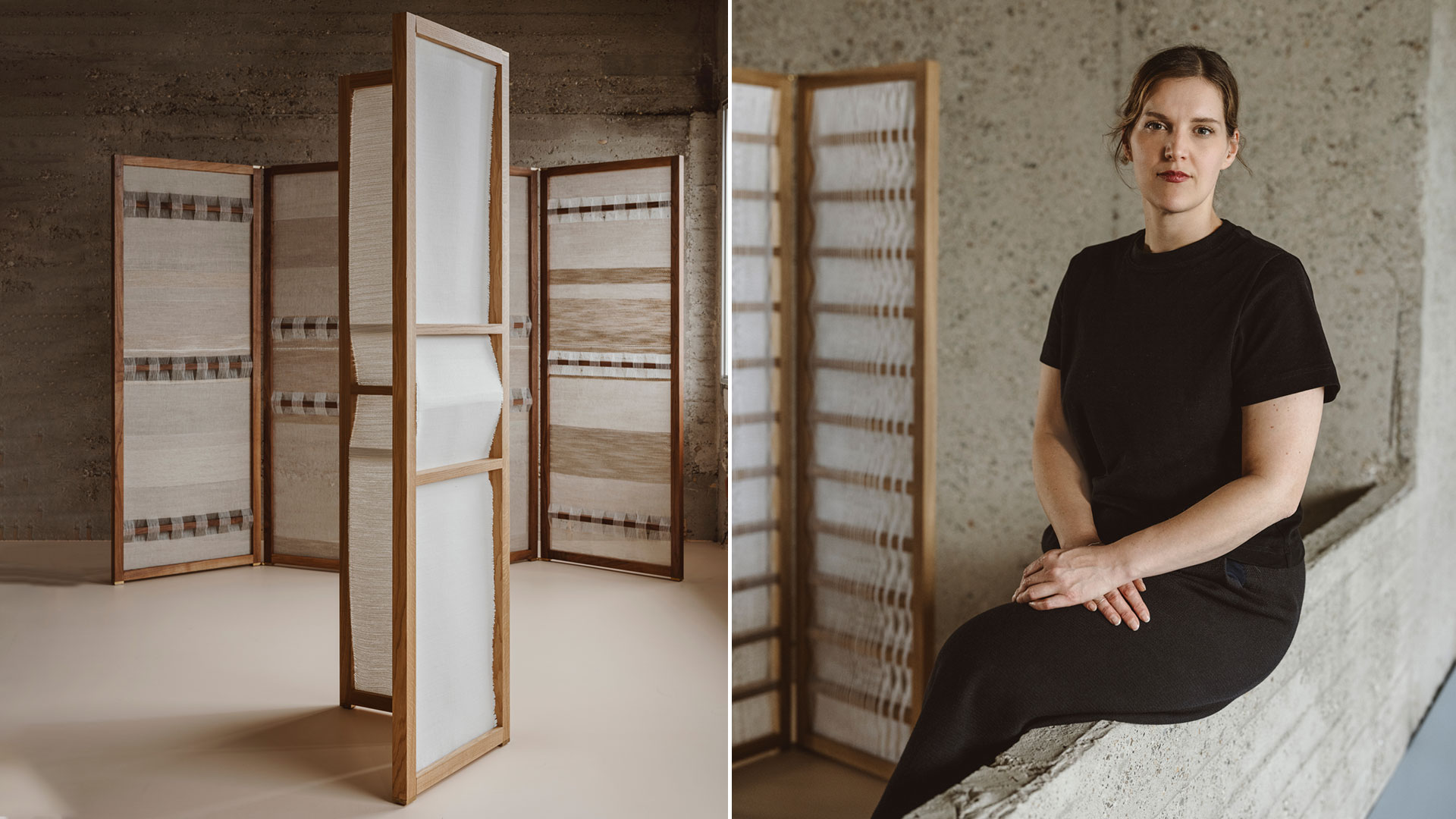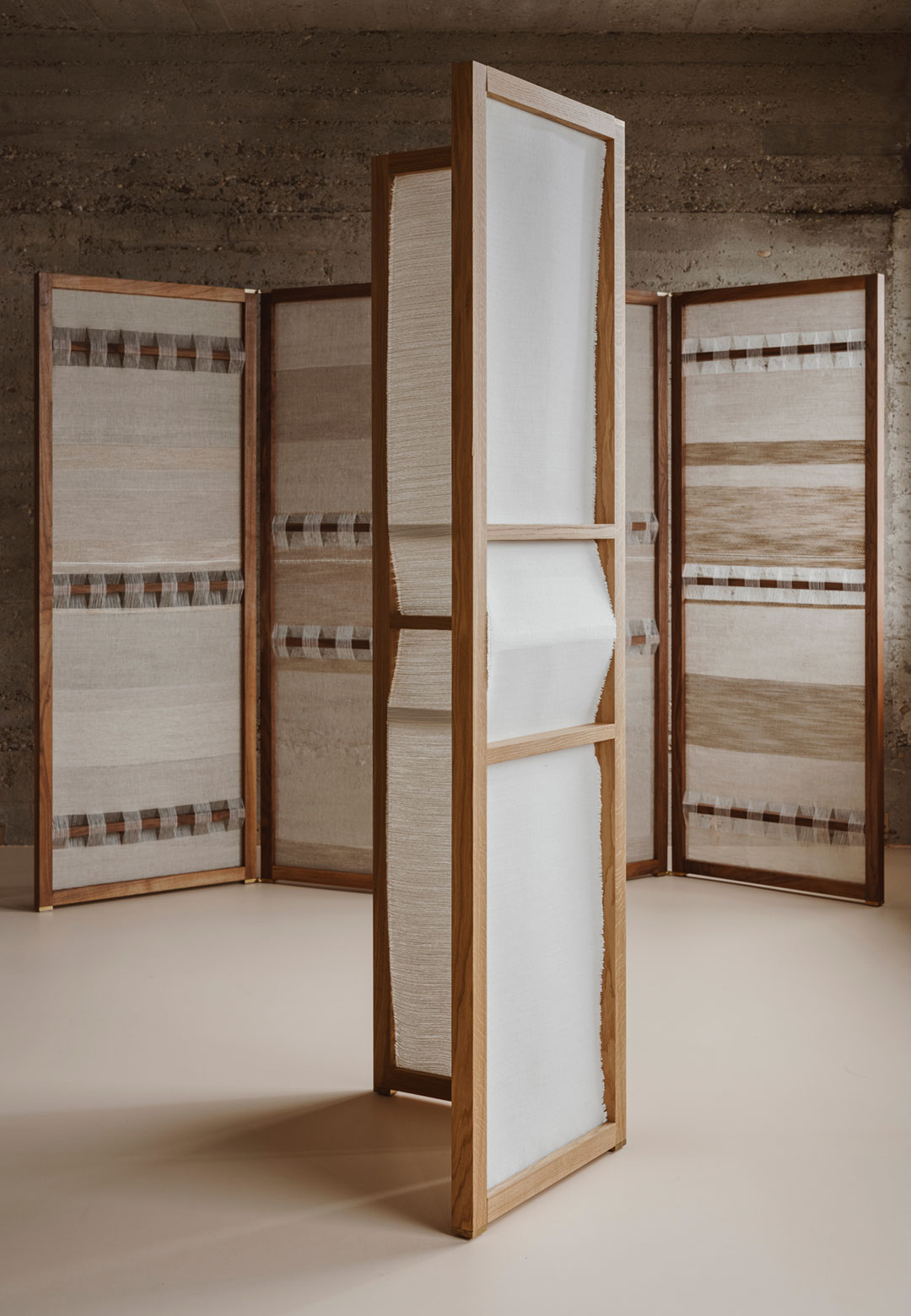Based in Antwerp, Belgium, Nathalie Van der Massen is a creative who strives to epitomise sensitivity in her oeuvre of textile design and art. Throughout her professional journey, she has been recognised for her unique position in the textile industry, achieved through creating both unique artworks and fabrics for domestic spaces—treading the boundary between art and design. Intangible elements such as light, time and sound, that amuse the textile designer, find a place in her experimental and poetic designs in which tactility is central. Recently, Massen was also honoured with the prestigious Henry van de Velde Young Talent Gold Award, acknowledging her contributions to the industry and her ability to craft pieces that shapeshift as both design and art. "The Young Talent Award is a valuable recognition of my professional journey so far. As a designer, there is always the need to showcase your work, although it remains challenging to expose yourself so vulnerably. The fact that my work is displayed and elicits such positive reactions deeply touches me," Massen says.
While pursuing her Master’s degree in graphic design, Massen developed a passion for textiles when working at the Textile Museum in Tilburg. Following this newfound fascination, she pursued a Master’s degree in textile design and in 2018, established her independent design studio working in the sphere of textile design, art and interior architecture. Her work is characterised by natural materials and a harmonious blend of industrial and artisanal methods; the potential of textiles as an autonomous, spatial and acoustic element in interior architecture takes centre stage in her approach. Massen’s latest collection of three limited edition room dividers, Ren, reiterates her quest to yield sensory experiences through her creations.
STIR dives deeper into this expressive yet subtle repository in a conversation with Massen where she delineates her creative language, inspirations, design process and plans for the future.
Anushka Sharma: How would you best describe your design philosophy?
Nathalie Van der Massen: My design philosophy revolves around eliciting a sensory experience within a space. I constantly inquire, 'How can I add a layer that triggers an emotional response, and how can I structure this experience to enhance its value for the user?' In my latest collection of room dividers, named Ren, I have employed the typology of the dividers to introduce additional depth and organisation to the space. Through the choice of fabrics, my work engages in a dialogue with both light and sound, adding layers of complexity. Moreover, it serves as an aesthetic enhancement. I am driven by the exploration of utilising existing or ancient techniques to craft new narratives within my designs.
Anushka: You pursued a master’s degree in graphic design before honing your passion for textiles. Does it guide or influence your textiles in any way?
Nathalie: My journey through a master's program in graphic design has definitely shaped my approach to textiles. There's an inherent graphical quality infused into my work—a subtle interplay of deconstruction and magnification, echoing techniques I learned during my studies. Particularly in my latest pieces, the focus is on stripping the work down to its essence, almost akin to a form of minimalism. Additionally, there's a consistent presence of geometric shapes that allude to the graphic nature of my background.
Anushka: Would you describe your work as textile design or textile art?
Nathalie: This is a challenging balance that I refuse to categorise, as I see the duality as a strength. I have a robust problem-solving methodology in my approach, akin to a designer's mindset. I dissect each situation, strategize the approach, and execute it meticulously. However, my interaction with materials leans more towards an artistic inquiry, driven by emotion and the creation of depth and layers. This artistic mindset and the freedom it entails continuously nourish my design mentality. Therefore, I view this duality not as a choice but as a pivotal interplay, each aspect informing and enriching the other.
Anushka: What was your response to receiving the prestigious Henry van de Velde Young Talent Gold Award?
Nathalie: At first, I could not believe it and never even considered myself a contender for such an honour. I have always seen myself as someone working more behind the scenes, so it came as a complete surprise and a delightful recognition. It truly reinforces my passion and gives me a significant boost to know that others acknowledge my work.
Anushka: Where do you look for inspiration? Are there bodies of work you take cues from?
Nathalie: I draw inspiration from a diverse array of sources spanning various mediums. This includes other artworks and artists, music, architecture, literature... For instance, Kenya Hara has been a key inspiration for conceptual thinking. His books, rooted in Japanese tradition, delve into conceptual thought, which greatly influences my approach. Steve O'Malley (_Sunn O)))), a metal band renowned for their visceral music, serves as another source. Their intense bass riffs create palpable vibrations that engulf you, evoking a sensory experience akin to being enveloped in a vacuum-sealed bag. I aim to infuse this sensory immersion into my own work. The oeuvre of Rothko evokes deep emotions within me, especially with his later works characterised by radical simplification, where dark expanses gradually reveal new dimensions, challenging the viewer's senses and intellect. Additionally, Anne Holtrop's architectural designs, particularly the sculptural and artistic elements embedded within her projects, inspire me greatly. Studio Mumbai remains an all-time favourite, especially their current exhibition at Fondation Cartier in Paris, showcasing their exceptional craftsmanship with Indian techniques and locally sourced materials. Their vibrant colour palette is particularly inspiring. While these sources of inspiration are temporally bound, there are countless other artists and works that continuously influence my creative process.
Anushka: What thought goes behind the selection of materials for your textiles?
Nathalie: I select materials based on their specific characteristics and my understanding of how I can manipulate them. For instance, I might choose thick paper yarn tightly spun to induce movement and add tension to the piece. Metal weaving achieves a similar effect. These are the considerations I carefully weigh when selecting materials, alongside colour choices.
Anushka: Your work blends natural materials with technological innovation. How do you find a balance between the two languages?
Nathalie: Working with natural and living materials is truly a humbling process. It is about finding a delicate balance between asserting control over the materials and respecting them enough not to force them into submission, as doing so could risk damaging their intrinsic qualities. This equilibrium involves a dance of holding on and letting go, where embracing imperfections not only adds depth to my work but also introduces a layer of human touch or narrative that I strive to incorporate. Even when working with industrial materials, infusing that human and personal element remains essential to me.
Anushka: Your work pays homage to both Belgian and European heritage of textile craftsmanship. How do you express these traditions without losing contemporary relevance?
Nathalie: I personally think there is no relevance to your work without knowing your roots. In Belgium, we possess a wealth of knowledge and craftsmanship, passed down through generations. While younger generations can enhance these traditions, there is also a risk of losing part of that heritage along the way. Our way of working is always influenced by our own reality and perception. Personally, I straddle the line between industrial and high-tech craftsmanship in weaving, while also being involved in architectural projects, giving me insight into both sides of the spectrum. This dialogue is incredibly relevant, prompting me to consider how to navigate between tradition, craftsmanship, and innovation. This heritage, this language, is passed down from generation to generation, and it is crucial to be fluent in it—it is truly something unique.
Anushka: What do you want your textiles to convey or express?
Nathalie: In my work, I strive to orchestrate and organise something intangible. For example, how light enters a space and how sound is filtered. These interventions are very subtle, but that is precisely what I find beautiful about them. I would like to think that if you were to remove them, you would notice their absence profoundly. My work conveys a sense of energy and evokes emotions. This holds whether it is applied to textiles or artwork.
Anushka: What is NEXT for you?
Nathalie: For me, the next step is Salone del Mobile. It is my first time participating, so I am incredibly excited and curious to see what unfolds. It is also the debut of my new collection, Ren, which adds to the anticipation. Being part of Belgium is Design is a significant milestone, as it showcases high-level initiatives alongside esteemed names—I am proud to be among them. Additionally, I am looking to further develop my collaboration with La Collection. As for future aspirations, I envision delving into more design projects and refining my craft. While I cannot specify particular names or brands I wish to work with, as I find that restrictive, I am drawn to projects where I have creative freedom and the client's trust. Recently, I received a brief where the client simply said, 'It has to be soft and amazing.' For me, that is the most motivating brief I could receive. These are the unicorn clients who understand my vision and trust my expertise.






 Sign in with email
Sign in with email










What do you think?